With many names – Curd Rice, Dahi Chawal, Thayir Sadam, Bagala Bath, Daddojanam etc. – this is a quintessential healthy dish which the South Indians swear by. And why shouldn’t they? Nothing comes close to being as easy, filling and delicious as the Curd Rice recipe, to fight the hot climate of South India. I’d say not just down south, Curd Rice has gained popularity in other parts of India as well over the years. Curd mixed with cooked rice and herbs, then tempered with spices – a simple and easy recipe.
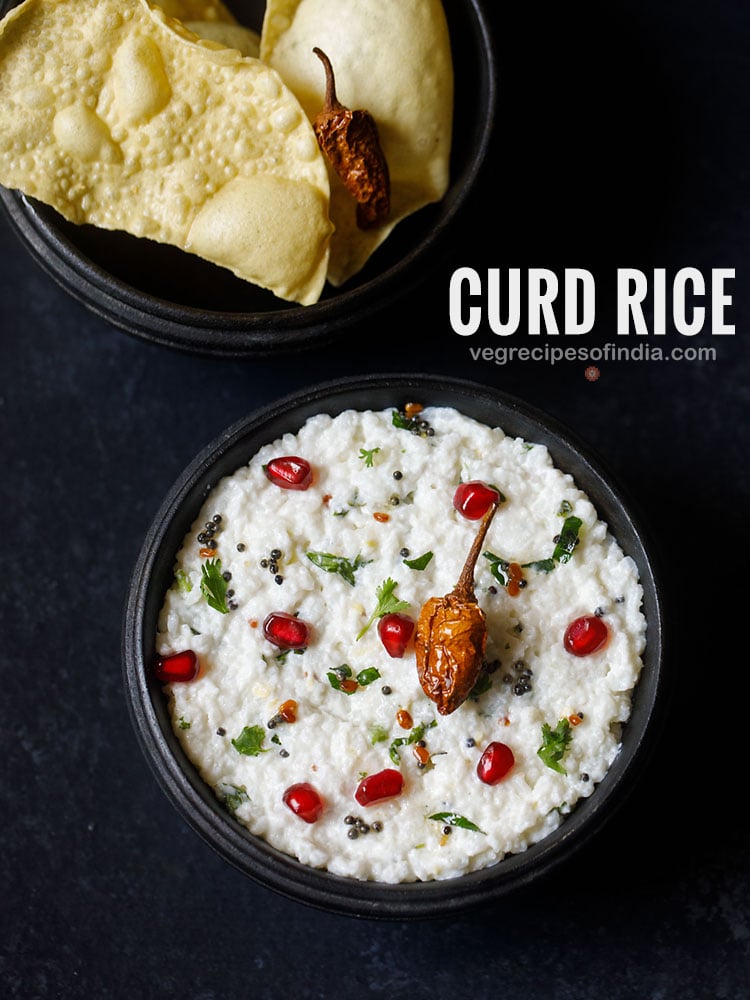
About Curd Rice
Curd Rice (Yogurt Rice) is typically a South Indian dish made of curd (yogurt), cooked rice, herbs and spices.
The states where it is most popularly consumed are Tamil Nadu, Karnataka, Kerala, Andhra Pradesh and Telangana. It is also quite common in Maharashtrian households.
As a staple preparation, Curd Rice is not tempered and mostly all South Indian meals end with this version. However, the one with a tempering can be had as a meal or be served in formal gatherings and also as prasadam or naivedyam in temples.
Table of Contents
The regional cuisine of a particular state may have an influence in the way it is prepared. Thus, a Curd Rice recipe may have alterations depending on the state you are in.
But the common thread that binds all these variations is the use of base ingredients, which remains consistent in each recipe.
Monikers under which the Curd Rice is famous in different states are:
- Thayir Sadam or Bagala Bath in Tamil Nadu
- Mosaranna in Karnataka
- Thayir Choru in Kerala
- Perugannam or Daddojanam in Telangana and Andhra Pradesh
- Dahi Bhat in Maharashtra
About My Recipe
As I mentioned above, a Curd Rice recipe can have many variations. This also depends on recipes that individual households may follow.
For instance, I usually make the Thayir Sadam with the recipe that I’ve shared in this post, which is actually a family favorite.
The most basic way of preparing the Curd Rice or Daddojanam is just by mixing cooked rice, curd and salt. To this simple mixture, you can always add spices and flavorings according to what your palate desires or likes.
Even in South India, the recipe is more or less similar, with a spice tempering added. This makes it more flavorful and tastier.
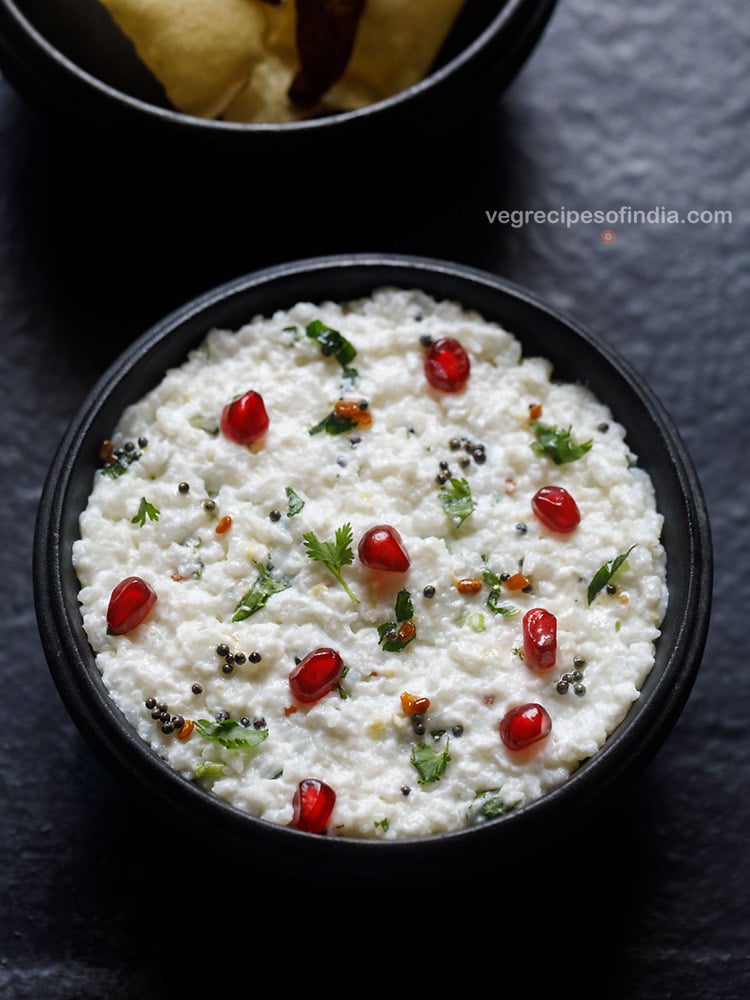
Other than the curd and the rice, the ingredients that go in my Curd Rice recipe are milk, green chilies, ginger, curry leaves and coriander leaves.
For the tempering, I fry mustard seeds, husked and split black gram (urad dal), curry leaves and asafoetida in sesame oil. You can make this in coconut oil too.
I love the flavor of fresh herby coriander and sweet pomegranate pearls in my Thayir Sadam. So, I prefer to add these as a garnish at the end. Once you try this Curd Rice recipe, I’m sure you’ll keep asking for more.
Grapes is also a good option as a garnish on this dish. If you want none of these, have it just plain. Or pair it with fried, sun-dried green chilies or this lovely Andhra Mango Pickle or the spicy, tangy Gongura Pachadi.
How to make Curd Rice
Cook Rice
1. Rinse ½ cup rice a couple of times in water. Use any variety of regular rice. I used sona masuri rice.
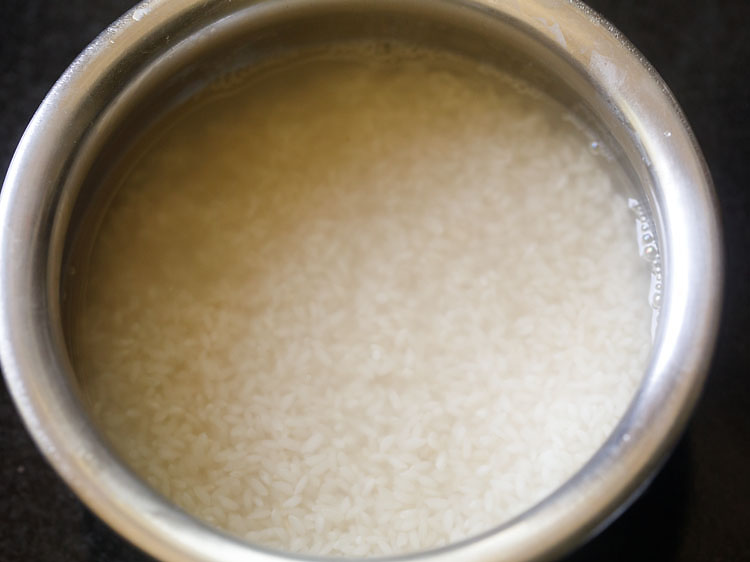
2. Then, add the rice in a 2 liter stovetop pressure cooker.
I have cooked the rice in a pressure cooker, but opt to cook in a pan on the stovetop or in the Instant Pot adding water as required.
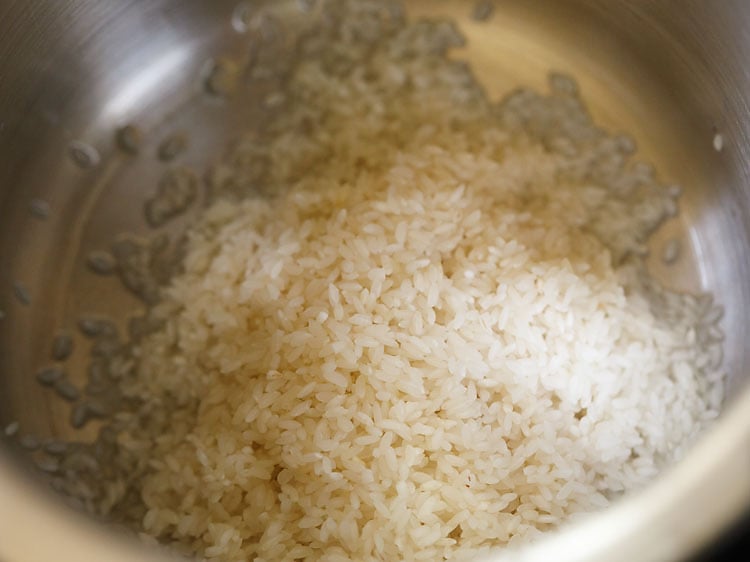
3. Add 1.5 cups water and stir to mix.
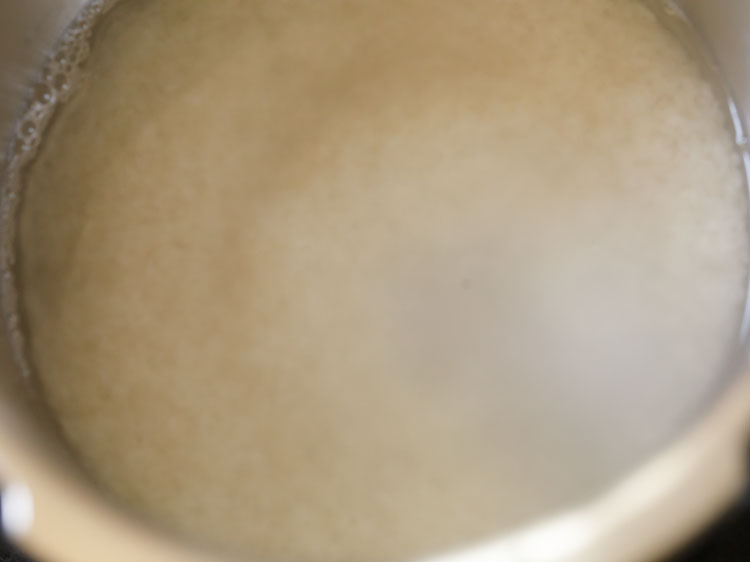
4. Pressure cook rice on medium heat for 5 to 6 whistles, 8 to 9 minutes or till the rice grains are cooked and softened well.
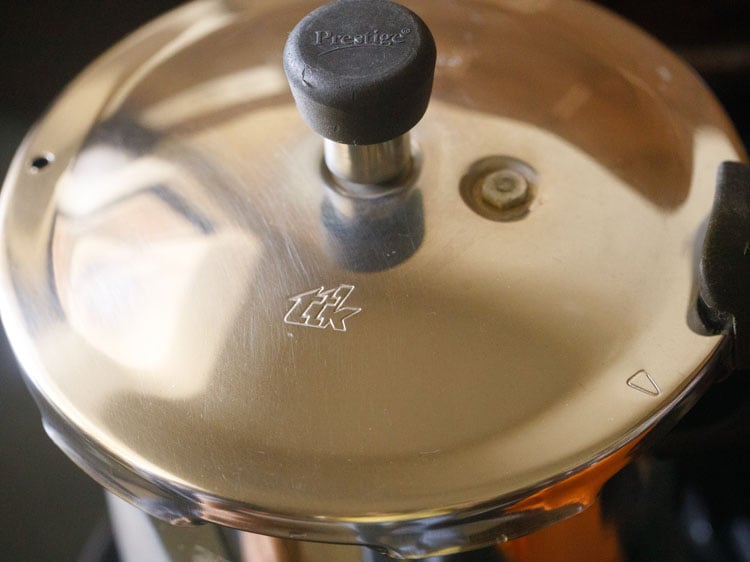
5. When the pressure settles down naturally in the cooker, then only remove the lid and check the doneness of rice.
The rice has to be softer than what we cook on a daily basis. Basically the grains should have a mushy texture after getting cooked.
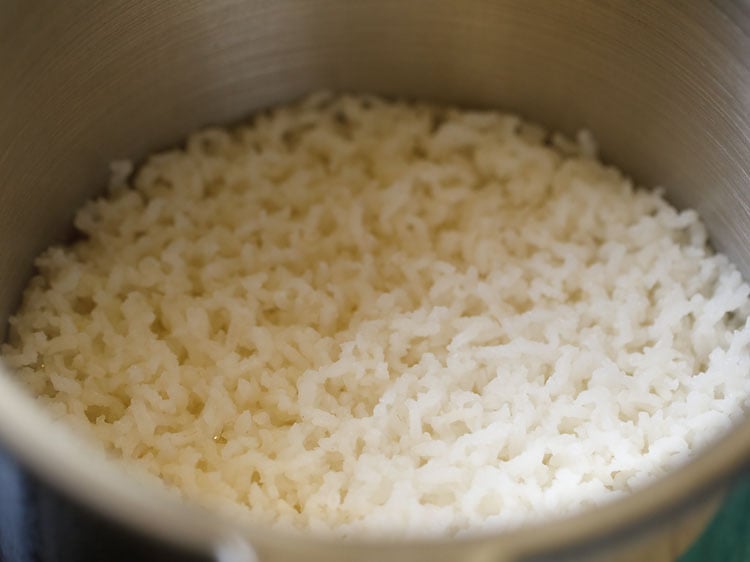
6. With a spoon or masher, mash the rice. Close the cooker and allow the rice to cool down.
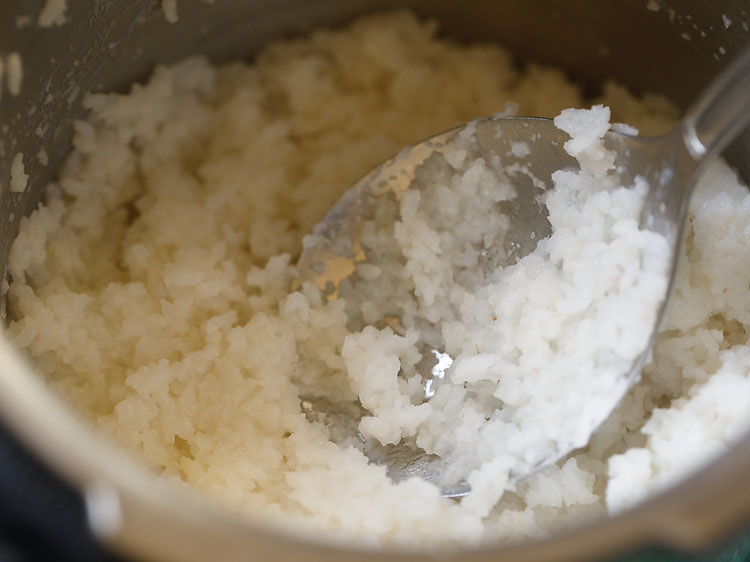
7. Take the mashed rice in a mixing bowl or you can even keep in the cooker if you want. Cover and let the rice become lukewarm or come to room temperature.
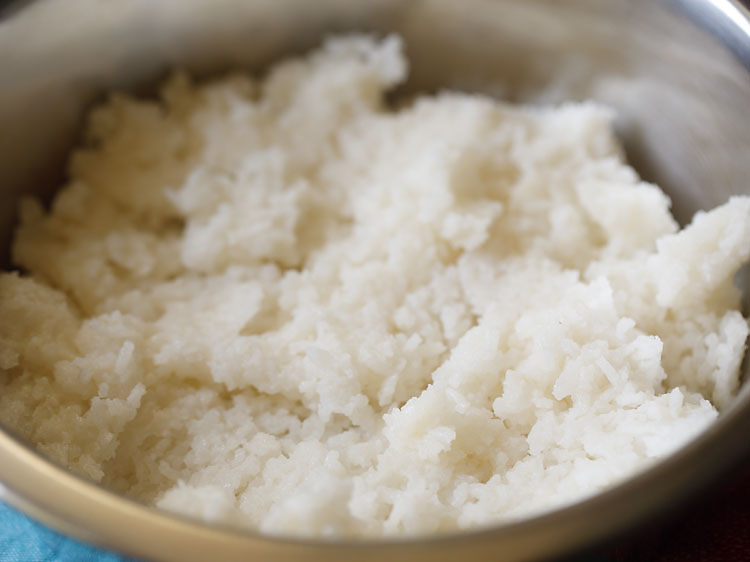
Make Curd Rice
8. When the cooked rice comes to room temperature and cools completely, add 1 cup fresh curd.
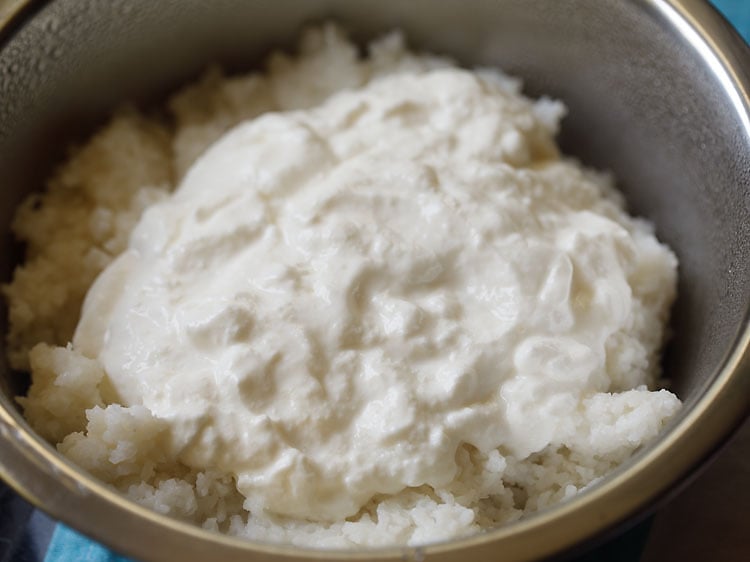
9. Next, add ¼ cup milk. The amount of milk that needs to be added will depend on the sourness in the curd. Since I used fresh curd, I have added less milk.
You can increase the quantity as required or skip adding milk altogether.
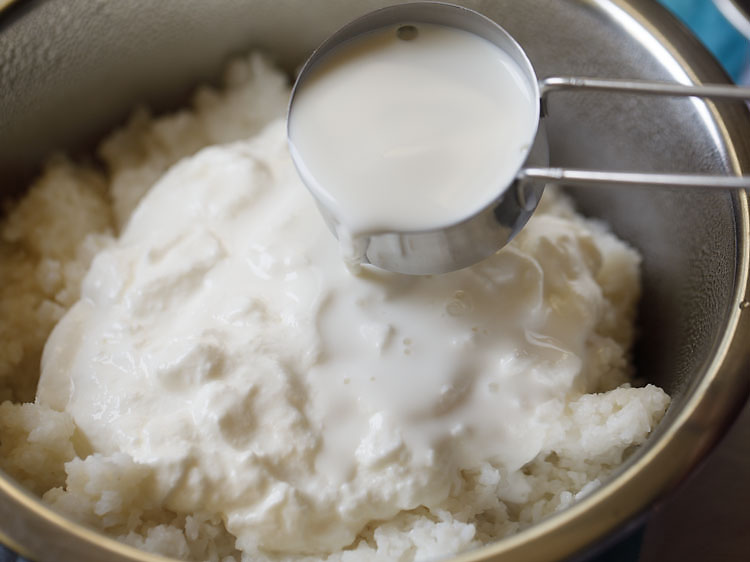
10. Mix very well and break lumps, if any. You can either use a spoon or a vegetable masher to break the lumps.
The consistency has to be slightly loose and not thick. If the consistency is thick, then you can add some more curd or milk.
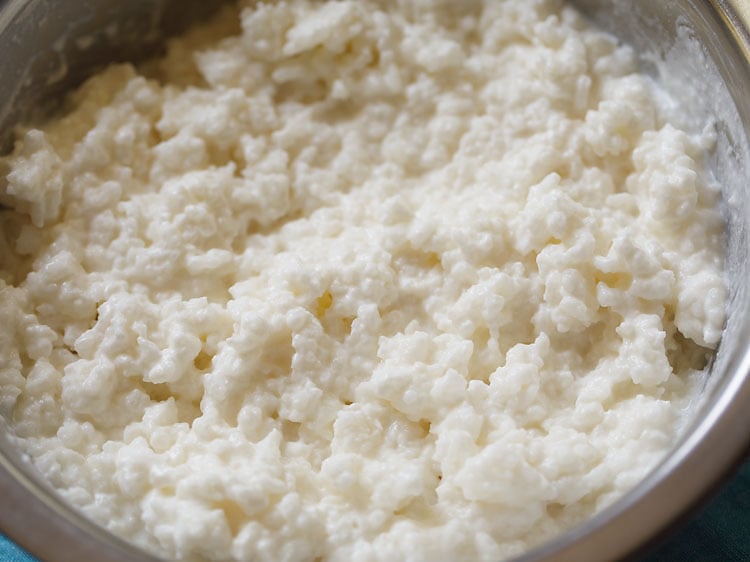
11. Add the following listed spices and herbs:
- 1 teaspoon finely chopped ginger
- 1 chopped green chili
- 1 tablespoon chopped coriander leaves
- 1 teaspoon finely chopped curry leaves
Instead of adding ginger and curry leaves to the rice, you can also fry them in the tempering.
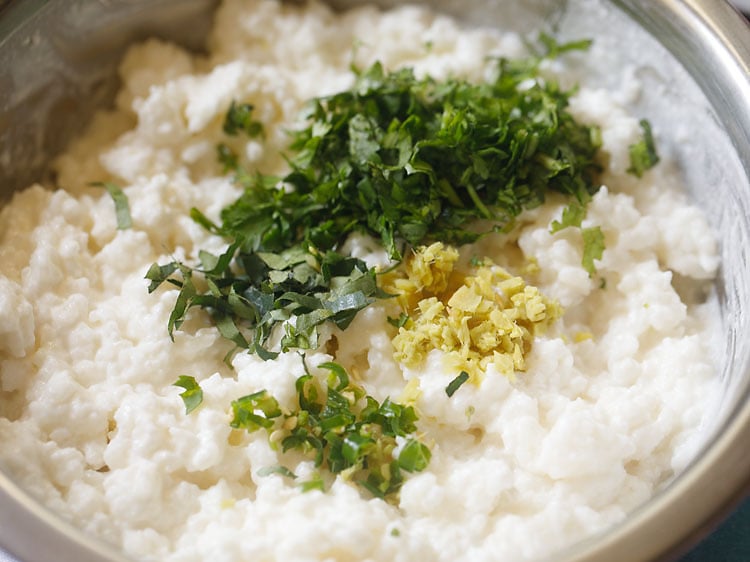
12. Add salt as per taste.
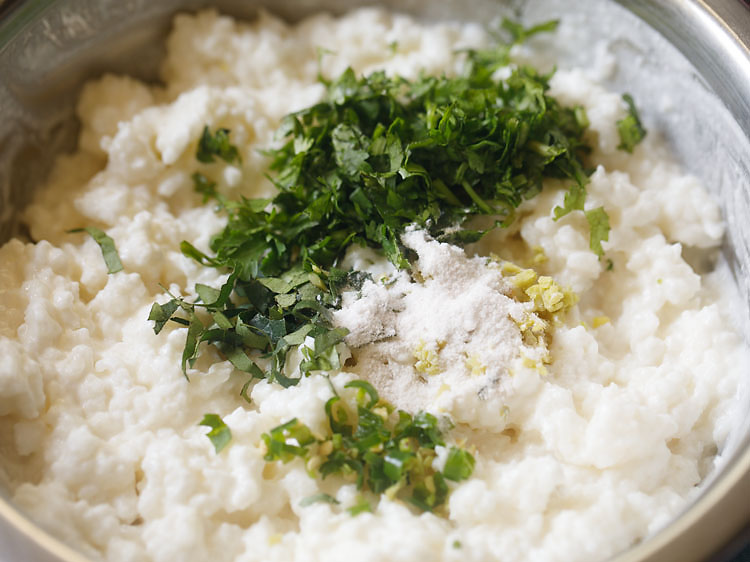
13. Mix very well. Keep aside. Check the taste and add more salt if required.
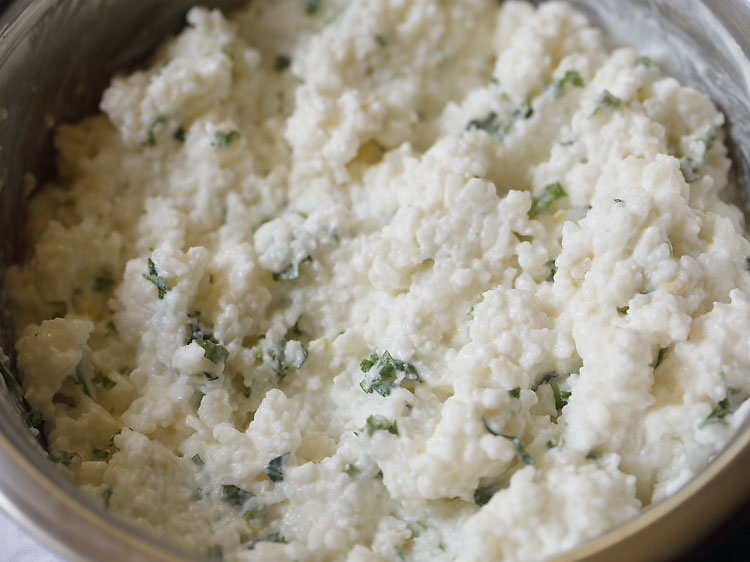
Temper Thayir Sadam
14. Heat a small pan or tadka pan and add 1 tablespoon sesame oil (gingelly oil) in it. You can use peanut oil or sunflower oil instead of sesame oil.
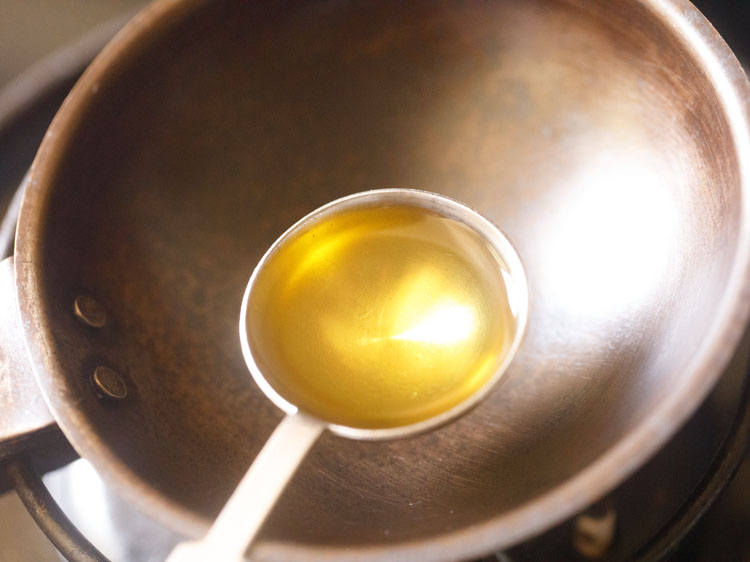
15. When the oil is hot, add ½ teaspoon mustard seeds. Keep heat to a low.
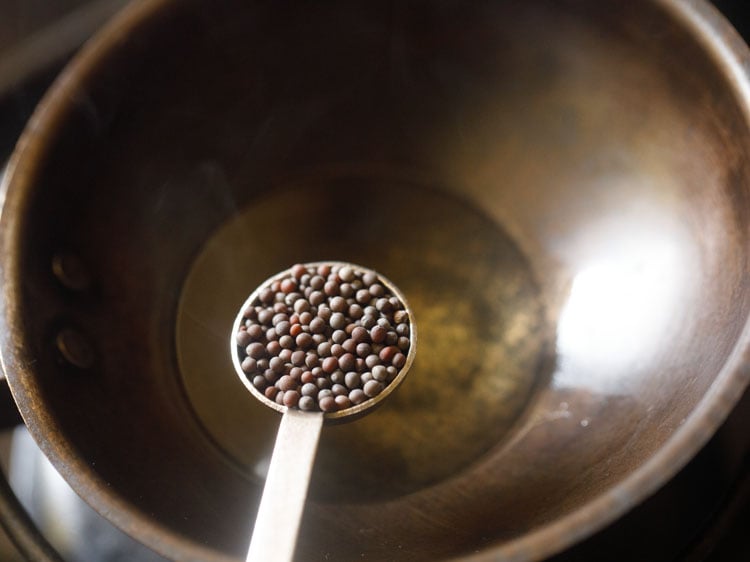
16. Let the mustard seeds begin to crackle.
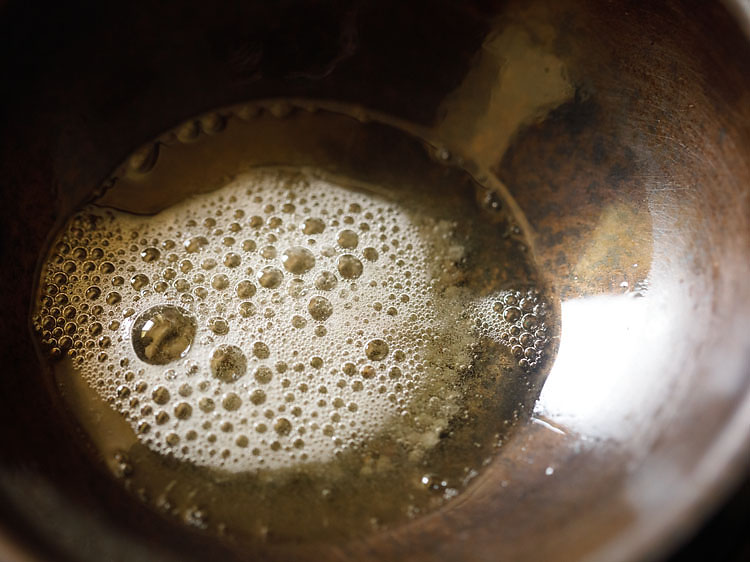
17. When the mustard seeds crackle, add ½ teaspoon urad dal.
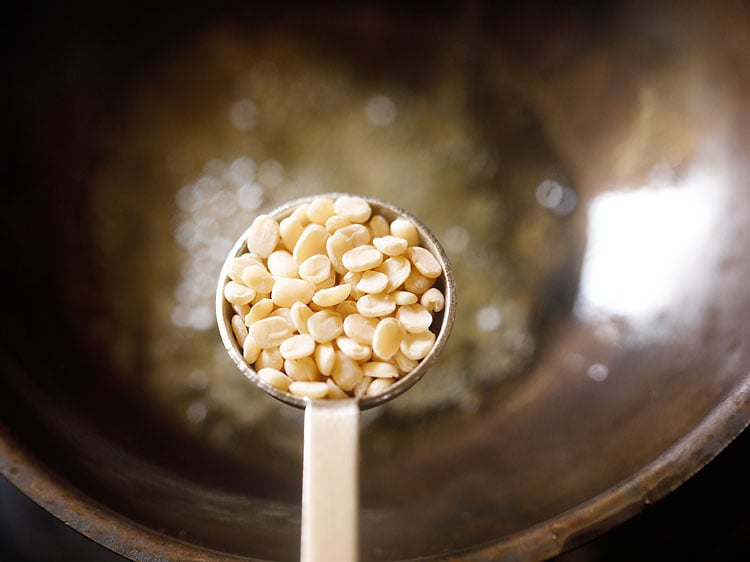
18. Stirring often, fry the urad dal.
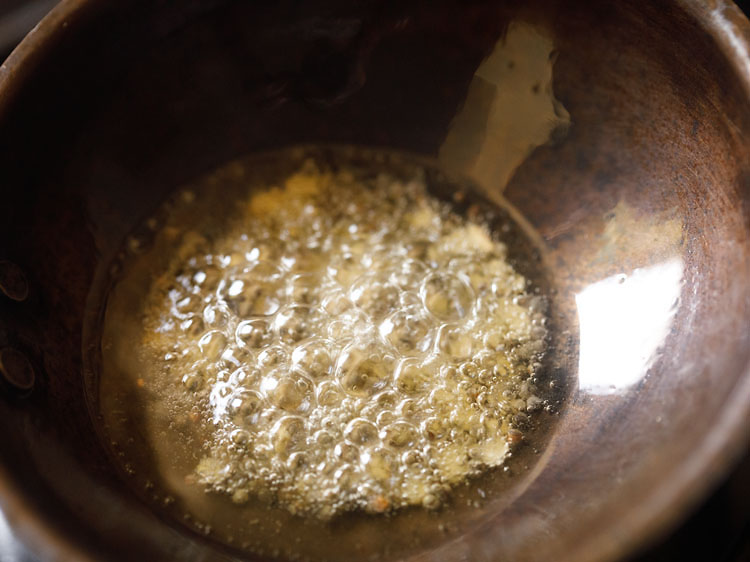
19. Let the urad dal become golden.
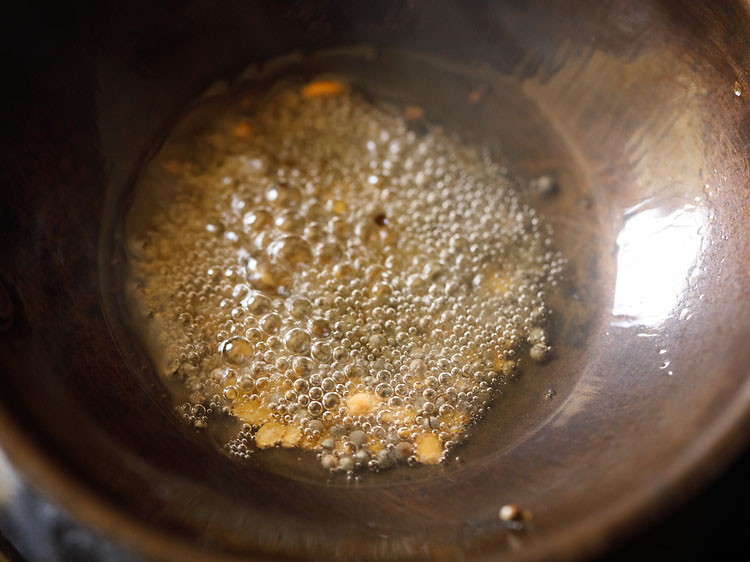
20. Then, add 5 to 6 chopped curry leaves and ⅛ teaspoon asafoetida (roughly 2 pinches of asafoetida). Mix and switch off the heat.
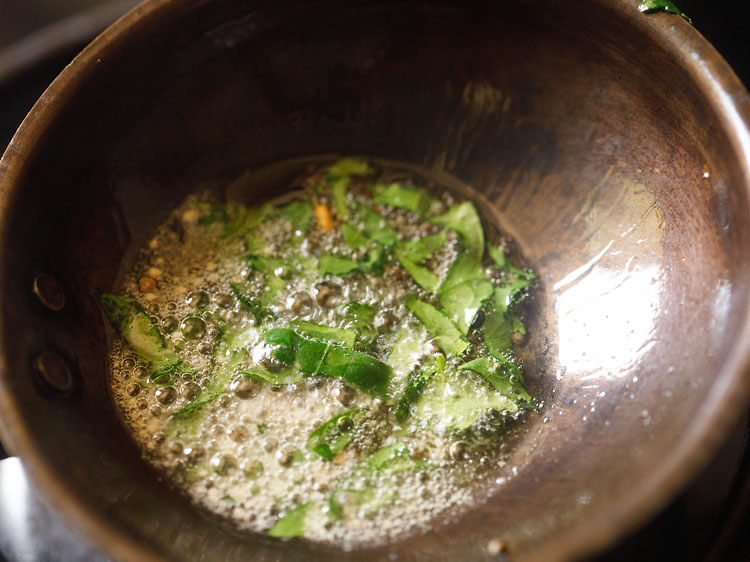
21. Immediately pour the tempering on the Curd Rice.
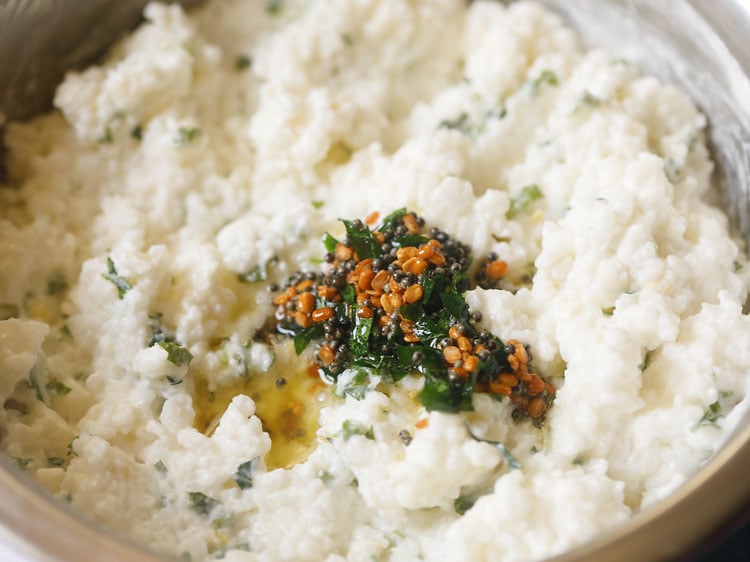
22. Mix very well, once again.
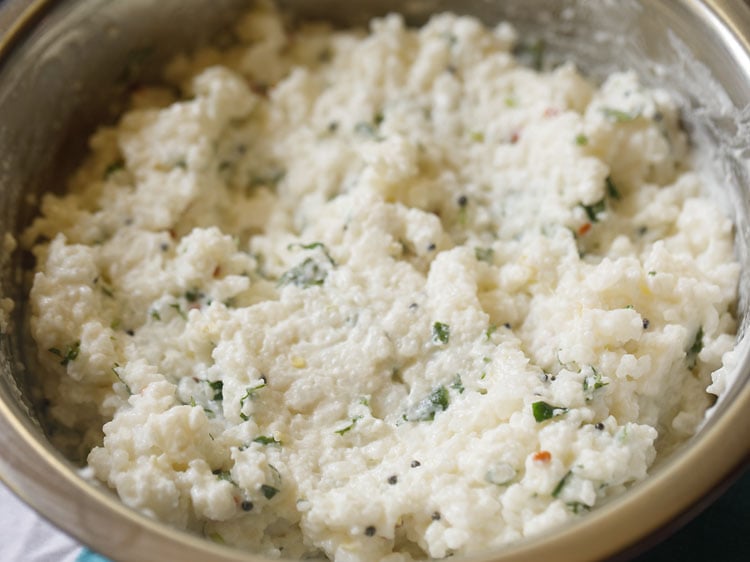
23. You can garnish Curd Rice with a few coriander leaves, pomegranate arils or grapes before serving. You can skip the fruits too.
Serve with a side of appalam or pappadums. You can even serve with a South Indian mango pickle or fried mor milagai (green chilies soaked in curd-salt solution and then sun dried).
If not serving immediately, keep the Curd Rice or Daddojanam at room temperature for a couple of hours or refrigerate for a few hours.
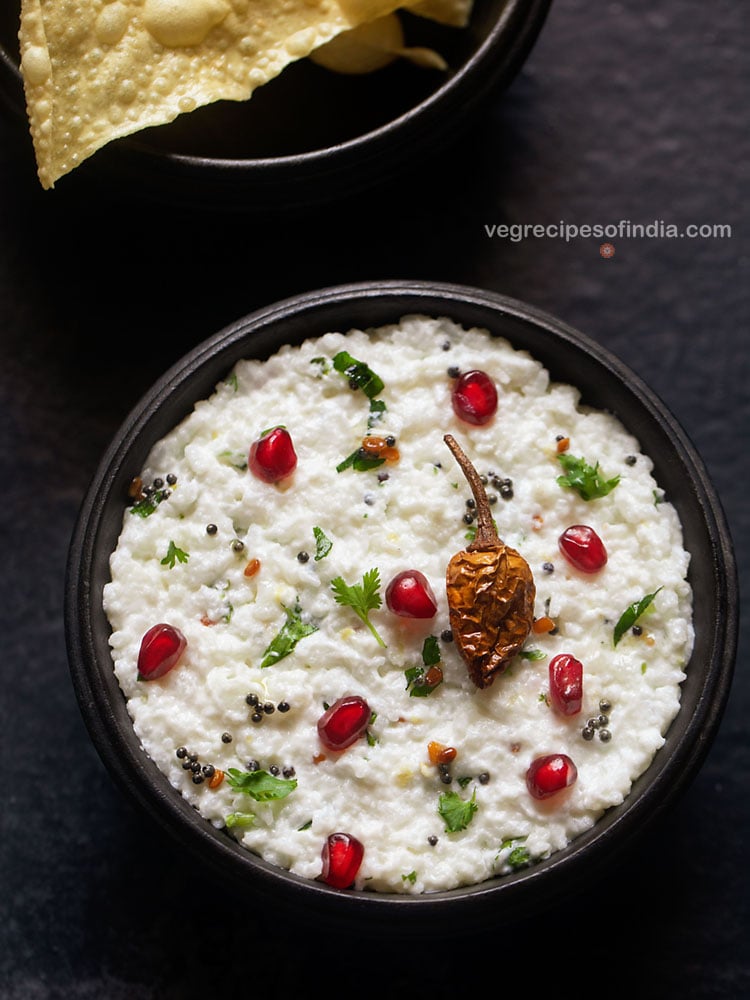
Ayurveda and Curd
Since I read a lot about Ayurveda and have been following it from quite some time, I’ve known some important points related to the consumption of this dish/curd according to the Ayurvedic perspective.
Contrary to the popular belief of the cooling nature of curd, Ayurveda mentions it having a hot nature and heavy to digest.
So, if you too are an ardent follower of this science, these are the points that you should keep in mind:
- If you have an aggravated pitta or kapha dosha, that is an imbalance in the body and mind, you should avoid eating Curd Rice. Buttermilk is a good option instead.
- The dish is good for people with vata dosha imbalance.
- You should always have fresh, well-set curd. Not the one which has turned extremely sour.
- Use homemade curd as far as possible for this Curd Rice recipe or any other curd-based recipe.
- Avoid heating curd as it destroys the friendly bacteria present in it.
- You should also not consume curd in the night as it increases the mucus.
- If you are making Thayir Sadam in summers, use buttermilk instead of curd.
Curd Benefits
While you may want to consider the consumption of curd in a certain way according to the Ayurveda way of life, it is also a proven point that curd is a nutrient rich and good for the health.
Here’s how:
- Curd is rich in calcium, proteins, good fats, vitamins and minerals. Hence, an excellent source choice for vegetarians. Vegans can have curds made with plant-based ingredients or food stuffs.
- The probiotic bacteria in curd are great for your digestive health.
- It is known to reduce chances of constipation, diarrhea and bloating.
- Research also says that curd is good in reducing stress and anxiety.
In addition to this Thayir Sadam recipe, these Curd Recipes will give you more choices. My suggestion is trying each and every recipe. All of them are really worthy.
Expert Tips for Best Curd Rice
- Rice: Make this dish with rice that has been freshly cooked and then cooled. You can also use leftover rice that has been cooked on the same day. Avoid using refrigerated and day old rice.
- Mixing: Do not mix the curd with hot rice. First it will kill the gut-friendly bacteria present in the yogurt and secondly the curd may split or separate with separation of the whey.
- Vegan Options: Veganize the recipe by using a plant based yogurt and milk – coconut, cashew, almond.
- Curd: I suggest using homemade curd. It has a completely different flavor as compared to the store-bought curd. Also, use fresh curd. However, if the curd is slightly sour, add some more milk.
- Proportions: Curd and milk proportion can be adjusted to suit your taste. Milk is usually added to avoid the curd from turning sour in summers. You can skip milk, if you want.
- More Add ins: Some grated carrots or beetroot can be added to the Curd Rice mixture. Makes the dish more nutritious. Note that the addition of beetroot will impart a pink color to the dish.
- Kid-friendly: When making it for kids, adjust or skip green chilies and ginger.
- Garnish Options: Cashews, fresh pomegranate pearls, grapes and raw mango pieces are some options. You can also sprinkle some chopped onions or cucumber or grated carrots on your curd rice or daddojanam if you prefer.
FAQs
Yes. In Tamil cuisine, it is known as Thayir Sadam.
Yes, you certainly can. As this dish is filling and keeps you full for a longer time, you will not indulge in unnecessary snacking.
In Tamil language, ‘thayir’ means yogurt/curd and ‘sadam’ means rice. Hence, the name.
Of course, you can add these fruits as a garnishing in Curd Rice or Daddojanam. It tastes really tasty with these.
More South Indian Rice Varieties!
South Indian Food Recipes
Rice Recipes
Rice Recipes
If you’ve tried this recipe, please rate it in the recipe card or leave a comment below – I’d love to hear your feedback. For more vegetarian inspiration, sign up for my email updates or follow me on Instagram, Youtube, Facebook, Pinterest or X.
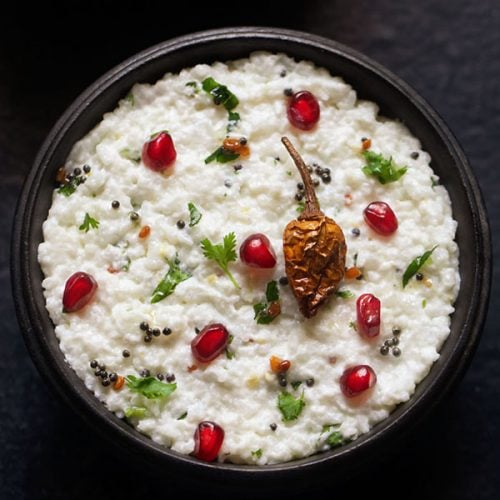
Curd Rice Recipe | Daddojanam | Thayir Sadam
Ingredients
For cooking rice
- ½ cup rice – 100 grams, any short grained to medium-grained rice
- 1.5 cups water – for pressure cooking
Other ingredients
- 1 cup Curd (yogurt) – 250 grams
- ¼ cup milk – optional
- 1 green chilli chopped or ½ teaspoon
- 1 teaspoon ginger – finely chopped
- 1 teaspoon curry leaves – finely chopped or 4 to 5 curry leaves, chopped
- 1 tablespoon coriander leaves (cilantro), chopped
For tempering
- 1 tablespoon sesame oil (gingelly oil)
- ½ teaspoon mustard seeds
- ½ teaspoon urad dal (husked and split black gram dal) – optional
- 5 to 6 curry leaves – chopped or kept whole
- ⅛ teaspoon asafoetida (hing)
For garnish
- 1 to 2 tablespoons pomegranate arils – optional, sweet grapes can also be added instead
- 1 tablespoon coriander leaves – chopped
Instructions
Cooking rice
- Rinse the rice grains a couple of times in water. Then add the rice in a 2-litre stovetop pressure cooker.
- Add 1.5 cups water. Stir and mix very well.
- Pressure cook rice on medium heat for 5 to 6 whistles or 8 to 9 minutes till the rice is cooked and softened very well.
- When the pressure settles down on its own, remove the lid and check the doneness of rice. The rice has to be more softer than what we cook on a daily basis and look mushy.
- With a spoon or vegetable masher, mash the rice. Close the cooker and allow the rice to become lukewarm or come at room temperature.
Making curd rice
- When the rice becomes comes at room temperature and has completely cooled, add fresh curd and milk.
- Mix again very well and break lumps if any. You can either use the spoon or masher while breaking the lumps.
- Add finely chopped ginger, finely chopped curry leaves, chopped green chilies and chopped coriander leaves.
- Instead of adding ginger and curry leaves to the rice, you can also fry them in the tempering.
- Add salt. Mix very well. Keep aside.
Tempering
- Heat a small pan or tadka pan and add sesame oil in it. You can use peanut oil or sunflower oil instead of sesame oil.
- When the oil becomes hot, lower the heat. Add mustard seeds.
- Let the mustard seeds crackle.
- Then add urad dal. Urad dal is optional and can be skipped.
- Fry on a low heat stirring often till the urad dal becomes golden.
- Lastly add the add curry leaves and asafoetida. Mix very well.
- Switch off the heat and immediately pour the tempering in the curd rice mixture. Again mix very well.
- Serve Curd Rice topped with a few coriander leaves or pomegranate arils or grapes. You can skip the fruits too and just serve curd rice as is. You can also serve with fried sun dried green chillies or any South Indian mango pickle.
- Store any leftovers in the refrigerator for some hours. Better to eat on the same day.
Video
Notes
- Curd rice is best made with rice grains that have been freshly cooked and cooled. You can also use rice that has been cooked on the same day. But avoid using refrigerated or a day old rice.
- For small kids, you can skip the green chillies and ginger completely.
- Some grated carrots and or beetroot can also be added. Note that beetroot will impart a pink color in the curd rice.
- Use fresh curd or yogurt. Avoid adding curd that tastes very sour.
- For vegan curd rice, use plant based yogurt like coconut milk yogurt or cashew milk yogurt or almond milk yogurt. Use plant based milk like thin coconut milk, cashew milk or almond milk.
- Pomegranate arils can be skipped.
- This curd rice recipe can be doubled or tripled.
Nutrition Info (Approximate Values)
This Curd Rice recipe from the archives first published in July 2016 has been republished and updated on January 2023.
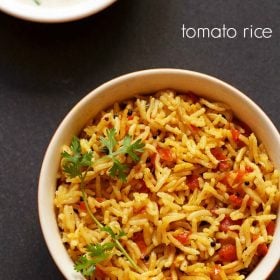
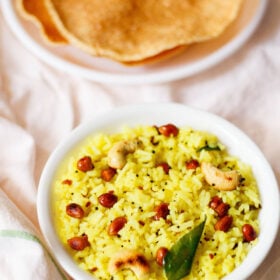
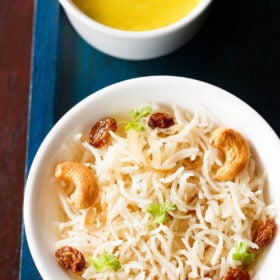
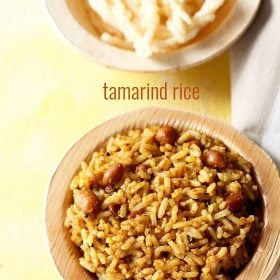
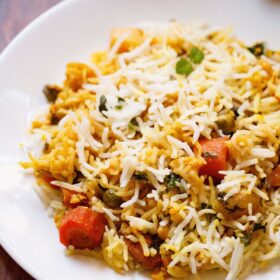
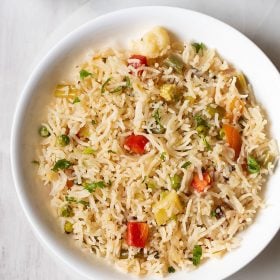
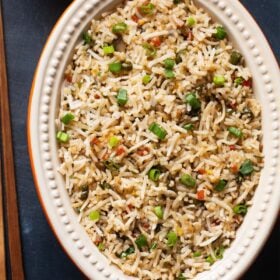
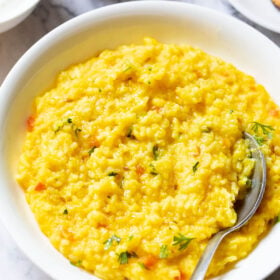








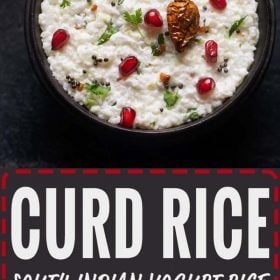
Can I skip the milk in this recipe?
Yes of course, just increase the amount of curd to ¼ cup.
Looks yummy. But can it be done without sesame oil as i don’t like it ? Or may be some substitution for it ? Thank you.
Thanks. You can use any neutral flavored oil (like sunflower oil or avocado oil) instead of sesame oil.
i never had this before – i followed your instructions and found it very tasty indeed – thanks again dassana
Thank you. Glad to know.
One more easy to make but immensely tasty recipe in my pocket, so yummy this rice!
Thank you.
Hi, I have a question, please. I do not have a pressure cooker; I only cook rice in a rice cooker or in a regular pot on the stovetop. How should I cook rice to get this type of softness? Should I add a little more water in the rice cooker, or should I do it on the stovetop?
For the rice cooker, add more water to the rice and cook for some more time. If cooking in a pan on the stovetop, cook the rice grains with the boiling method, where more water is added. Later when rice grains are softened, the water is drained. Here you can check the softness of the rice while the rice is simmering and also can cook further for the rice grains to become more soft.
Are the dal beans supposed to be hard or soft after tempered? I love curd rice but not with really hard lentils.
You can make them without lentils. The curd rice will still taste good.
Hi Dassana,
Thanks for the curd rice recipe. Being a vegetarian, I follow many of your recipies.
As you said that you follow ayurveda so I have a small doubt that according to ayurveda milk and salt and milk and curd are viruddhahar( which does not go together). So in this recipe you have added milk. Can you please clear my doubt.
With gratitude,
Neelu
Hi Neelu, thank you. Yes, you are right here. I have added milk so that the curd rice does not get spoiled and it is optional. You can just make curd rice with curd only and I also do this way at times. Regarding Ayurveda, I do not strictly follow it and allow myself to be free and relaxed in cooking on occasions. I hope this helps.
cool
Hi Dassana. Awesome recipe for curd rice. I made today and everyone loved it. Thanks for sharing.
hi vinitha, thanks for sharing this lovely feedback. glad to know. happy cooking.
I tried the recipe,
Seems healthy
Made curd rice from your recipe and it was so tasty. Thanks for sharing.
Welcome Anand. Nice to know this.
I thought curd rice is a recipe which is served chilled in the fridge.. is it so?
after preparing curd rice, you have to chill it, if you are not serving it immediately. since the curd will become more sour or can even get spoiled in the summer heat.
amazingly easy and effective!!
thanks prateek
Hi,what is masala elaichi?what is the difference between wheat rava and rice rava? Pls make mohanthal and dudhpak from Gujarati cuisine.
masala elaichi is the badi elaichi or the black cardamom. wheat rava is sooji and rice rava is idli rava. obviously wheat rava is made with wheat and rice rava is made from parboiled rice. will try to add these recipes. taken a note of.
Hi Dassana,
Thank you so much for this recipe as well as all your other recipes, you are so so lovely and so are all your recipes. I have learnt so much from your blog since past four years ❤️ I have been cooking this for my little one quite often now, just wished to know for how long or days can we store curd rice in the fridge and consume it?
Thank you
Thanks a lot Ritu and so glad to read your comment. When I have leftovers for curd rice, I just them refrigerate them for a day. It is best to have curd rice fresh, but if you are not able to have all of it, then one day in the fridge is fine. Homemade curd is highly perishable so best to use it as quick as you can.
just read the recipe.Sure I’m going to try it today evening.
surely try suresh and let us know how the curd rice was?